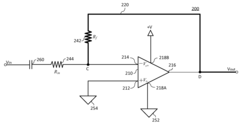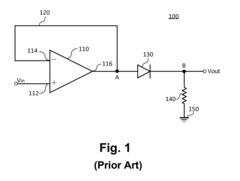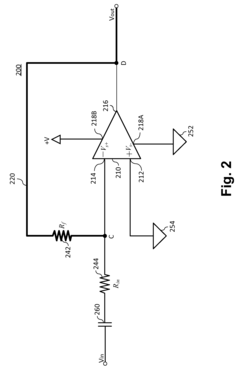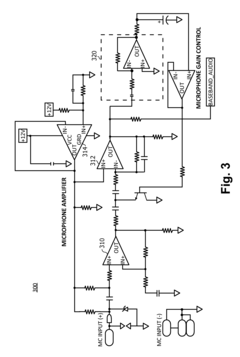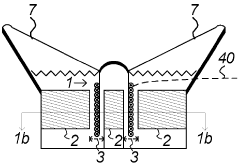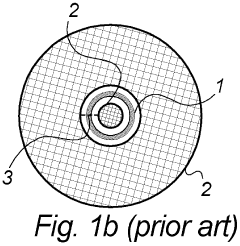Exploring Half Wave Rectifier Applications in Signal Processing
JUL 15, 20259 MIN READ
Generate Your Research Report Instantly with AI Agent
Patsnap Eureka helps you evaluate technical feasibility & market potential.
Half Wave Rectifier Background and Objectives
Half-wave rectification has been a fundamental technique in signal processing since the early days of electronics. This method, which converts alternating current (AC) to pulsating direct current (DC), has evolved significantly over the years, finding applications in various fields beyond traditional power supplies.
The development of half-wave rectifiers can be traced back to the invention of vacuum tube diodes in the early 20th century. As semiconductor technology advanced, solid-state diodes replaced vacuum tubes, leading to more efficient and compact rectifier designs. This progression has been crucial in shaping modern signal processing techniques.
In recent years, the focus has shifted towards exploring novel applications of half-wave rectifiers in signal processing. These applications extend beyond simple AC-to-DC conversion, encompassing areas such as signal conditioning, waveform shaping, and even advanced digital signal processing algorithms.
One of the primary objectives in this field is to enhance the efficiency and accuracy of half-wave rectification in signal processing applications. Researchers are working on minimizing signal distortion, reducing power loss, and improving the overall performance of rectifier circuits in various operating conditions.
Another significant goal is to integrate half-wave rectification techniques with emerging technologies. This includes exploring its potential in areas such as wireless power transfer, energy harvesting systems, and high-frequency applications in telecommunications and radar systems.
The miniaturization of electronic devices has also driven research into developing micro-scale and nano-scale half-wave rectifiers. These efforts aim to create ultra-compact rectification solutions for use in microelectronics, MEMS (Micro-Electro-Mechanical Systems), and other miniaturized signal processing applications.
Furthermore, there is growing interest in leveraging half-wave rectification principles in non-traditional domains. This includes potential applications in biomedical signal processing, where the technique could be used for processing physiological signals, and in environmental monitoring systems for analyzing natural phenomena.
As we look towards the future, the objectives for half-wave rectifier research in signal processing are becoming increasingly interdisciplinary. There is a push to combine this classic technique with advanced computational methods, such as machine learning and artificial intelligence, to create more adaptive and intelligent signal processing systems.
The development of half-wave rectifiers can be traced back to the invention of vacuum tube diodes in the early 20th century. As semiconductor technology advanced, solid-state diodes replaced vacuum tubes, leading to more efficient and compact rectifier designs. This progression has been crucial in shaping modern signal processing techniques.
In recent years, the focus has shifted towards exploring novel applications of half-wave rectifiers in signal processing. These applications extend beyond simple AC-to-DC conversion, encompassing areas such as signal conditioning, waveform shaping, and even advanced digital signal processing algorithms.
One of the primary objectives in this field is to enhance the efficiency and accuracy of half-wave rectification in signal processing applications. Researchers are working on minimizing signal distortion, reducing power loss, and improving the overall performance of rectifier circuits in various operating conditions.
Another significant goal is to integrate half-wave rectification techniques with emerging technologies. This includes exploring its potential in areas such as wireless power transfer, energy harvesting systems, and high-frequency applications in telecommunications and radar systems.
The miniaturization of electronic devices has also driven research into developing micro-scale and nano-scale half-wave rectifiers. These efforts aim to create ultra-compact rectification solutions for use in microelectronics, MEMS (Micro-Electro-Mechanical Systems), and other miniaturized signal processing applications.
Furthermore, there is growing interest in leveraging half-wave rectification principles in non-traditional domains. This includes potential applications in biomedical signal processing, where the technique could be used for processing physiological signals, and in environmental monitoring systems for analyzing natural phenomena.
As we look towards the future, the objectives for half-wave rectifier research in signal processing are becoming increasingly interdisciplinary. There is a push to combine this classic technique with advanced computational methods, such as machine learning and artificial intelligence, to create more adaptive and intelligent signal processing systems.
Market Demand Analysis for Signal Processing
The market demand for signal processing applications utilizing half-wave rectifiers has shown significant growth in recent years, driven by the increasing need for efficient and cost-effective signal conditioning solutions across various industries. The global signal processing market, which encompasses half-wave rectifier applications, is projected to reach substantial market value in the coming years, with a compound annual growth rate outpacing many other technology sectors.
Half-wave rectifiers play a crucial role in signal processing by converting alternating current (AC) signals into pulsating direct current (DC) signals. This fundamental capability has found widespread applications in power supplies, audio processing, sensor interfaces, and communication systems. The automotive industry, in particular, has emerged as a key driver for half-wave rectifier demand, as modern vehicles incorporate an increasing number of electronic systems requiring signal conditioning.
The consumer electronics sector also contributes significantly to the market demand for half-wave rectifier applications in signal processing. With the proliferation of smartphones, tablets, and wearable devices, there is a growing need for compact and energy-efficient signal processing solutions. Half-wave rectifiers offer advantages in terms of simplicity and reduced component count, making them attractive for portable device manufacturers seeking to optimize space and power consumption.
In the industrial automation sector, half-wave rectifiers are utilized in various signal processing applications, including sensor interfaces, motor control systems, and power management circuits. The ongoing trend towards Industry 4.0 and smart manufacturing has further boosted the demand for reliable signal processing components, including half-wave rectifiers, to enable precise control and monitoring of industrial processes.
The telecommunications industry represents another significant market for half-wave rectifier applications in signal processing. As 5G networks continue to expand globally, there is an increasing need for efficient signal conditioning and power management solutions in base stations and network infrastructure equipment. Half-wave rectifiers play a role in these systems by helping to convert and process signals in various stages of the communication chain.
Looking ahead, the market demand for half-wave rectifier applications in signal processing is expected to be influenced by emerging technologies such as Internet of Things (IoT) devices, edge computing, and artificial intelligence. These technologies require efficient signal processing capabilities at the device level, creating opportunities for innovative half-wave rectifier designs that can meet the demands of low-power, high-performance applications.
Half-wave rectifiers play a crucial role in signal processing by converting alternating current (AC) signals into pulsating direct current (DC) signals. This fundamental capability has found widespread applications in power supplies, audio processing, sensor interfaces, and communication systems. The automotive industry, in particular, has emerged as a key driver for half-wave rectifier demand, as modern vehicles incorporate an increasing number of electronic systems requiring signal conditioning.
The consumer electronics sector also contributes significantly to the market demand for half-wave rectifier applications in signal processing. With the proliferation of smartphones, tablets, and wearable devices, there is a growing need for compact and energy-efficient signal processing solutions. Half-wave rectifiers offer advantages in terms of simplicity and reduced component count, making them attractive for portable device manufacturers seeking to optimize space and power consumption.
In the industrial automation sector, half-wave rectifiers are utilized in various signal processing applications, including sensor interfaces, motor control systems, and power management circuits. The ongoing trend towards Industry 4.0 and smart manufacturing has further boosted the demand for reliable signal processing components, including half-wave rectifiers, to enable precise control and monitoring of industrial processes.
The telecommunications industry represents another significant market for half-wave rectifier applications in signal processing. As 5G networks continue to expand globally, there is an increasing need for efficient signal conditioning and power management solutions in base stations and network infrastructure equipment. Half-wave rectifiers play a role in these systems by helping to convert and process signals in various stages of the communication chain.
Looking ahead, the market demand for half-wave rectifier applications in signal processing is expected to be influenced by emerging technologies such as Internet of Things (IoT) devices, edge computing, and artificial intelligence. These technologies require efficient signal processing capabilities at the device level, creating opportunities for innovative half-wave rectifier designs that can meet the demands of low-power, high-performance applications.
Current State and Challenges in Half Wave Rectification
Half wave rectification, a fundamental technique in signal processing, has seen significant advancements and widespread adoption across various industries. Currently, the technology is extensively used in power supplies, signal demodulation, and voltage regulation applications. The state-of-the-art half wave rectifiers employ sophisticated semiconductor devices, such as high-speed diodes and precision op-amps, to achieve improved efficiency and accuracy in signal conversion.
Despite its widespread use, half wave rectification faces several challenges that limit its performance and applicability in certain scenarios. One of the primary issues is the inherent inefficiency of the process, as it only utilizes half of the input waveform. This results in a lower power output compared to full wave rectification, making it less suitable for high-power applications. Additionally, the pulsating nature of the output signal introduces significant ripple, which can be problematic in sensitive electronic systems.
Another challenge lies in the non-linear behavior of rectifying components, particularly at low signal levels. This non-linearity can introduce distortion and harmonic content, affecting the quality of the processed signal. Researchers and engineers are actively working on developing improved rectifier designs and compensation techniques to mitigate these effects and enhance overall system performance.
The miniaturization of electronic devices has also posed challenges for half wave rectification. As circuit sizes decrease, parasitic capacitances and leakage currents become more pronounced, potentially compromising the rectification efficiency. This has led to increased focus on developing novel semiconductor materials and device structures that can maintain high performance at reduced scales.
In the realm of high-frequency applications, such as in wireless communication systems, half wave rectifiers face limitations due to the finite switching speed of rectifying elements. This can result in reduced efficiency and increased power loss at higher frequencies. Ongoing research is exploring the use of advanced materials and device architectures to push the frequency limits of half wave rectification.
Environmental factors, such as temperature variations and electromagnetic interference, also present challenges to the stability and reliability of half wave rectifier circuits. Engineers are developing robust designs and implementing advanced compensation techniques to ensure consistent performance across a wide range of operating conditions.
The geographical distribution of half wave rectification technology development is primarily concentrated in regions with strong electronics and semiconductor industries. Countries like the United States, Japan, South Korea, and Germany are at the forefront of innovation in this field, with significant contributions also coming from emerging tech hubs in China and India.
Despite its widespread use, half wave rectification faces several challenges that limit its performance and applicability in certain scenarios. One of the primary issues is the inherent inefficiency of the process, as it only utilizes half of the input waveform. This results in a lower power output compared to full wave rectification, making it less suitable for high-power applications. Additionally, the pulsating nature of the output signal introduces significant ripple, which can be problematic in sensitive electronic systems.
Another challenge lies in the non-linear behavior of rectifying components, particularly at low signal levels. This non-linearity can introduce distortion and harmonic content, affecting the quality of the processed signal. Researchers and engineers are actively working on developing improved rectifier designs and compensation techniques to mitigate these effects and enhance overall system performance.
The miniaturization of electronic devices has also posed challenges for half wave rectification. As circuit sizes decrease, parasitic capacitances and leakage currents become more pronounced, potentially compromising the rectification efficiency. This has led to increased focus on developing novel semiconductor materials and device structures that can maintain high performance at reduced scales.
In the realm of high-frequency applications, such as in wireless communication systems, half wave rectifiers face limitations due to the finite switching speed of rectifying elements. This can result in reduced efficiency and increased power loss at higher frequencies. Ongoing research is exploring the use of advanced materials and device architectures to push the frequency limits of half wave rectification.
Environmental factors, such as temperature variations and electromagnetic interference, also present challenges to the stability and reliability of half wave rectifier circuits. Engineers are developing robust designs and implementing advanced compensation techniques to ensure consistent performance across a wide range of operating conditions.
The geographical distribution of half wave rectification technology development is primarily concentrated in regions with strong electronics and semiconductor industries. Countries like the United States, Japan, South Korea, and Germany are at the forefront of innovation in this field, with significant contributions also coming from emerging tech hubs in China and India.
Existing Half Wave Rectifier Solutions
01 Circuit design and components
Half wave rectifiers typically consist of a diode and a transformer. The diode allows current to flow in only one direction, effectively converting AC to pulsating DC. The transformer is used to step up or step down the input voltage as needed. Various circuit configurations and component selections can be employed to optimize performance and efficiency.- Circuit design and components: Half wave rectifiers typically consist of a diode and a transformer. The diode allows current to flow in only one direction, effectively converting AC to pulsating DC. The transformer is used to step up or step down the input voltage as needed. Various circuit configurations and component selections can be employed to optimize performance and efficiency.
- Voltage regulation and smoothing: To improve the output quality of half wave rectifiers, voltage regulation and smoothing techniques are often employed. This can involve the use of capacitors to reduce ripple, voltage regulators to maintain a steady output voltage, and feedback mechanisms to compensate for load variations. These enhancements help to produce a more stable and usable DC output.
- Power supply applications: Half wave rectifiers are commonly used in various power supply applications. They can be found in low-power devices, battery chargers, and some types of AC adapters. In these applications, the rectifier converts AC mains power to DC for use by electronic devices. The simplicity of the half wave rectifier makes it suitable for certain low-cost or low-power scenarios.
- Efficiency improvements: Researchers and engineers have developed various methods to improve the efficiency of half wave rectifiers. These can include the use of advanced semiconductor materials, optimized circuit layouts, and innovative cooling solutions. Some designs incorporate synchronous rectification or other techniques to reduce power losses and increase overall system efficiency.
- Integration with other circuits: Half wave rectifiers are often integrated with other circuit elements to create more complex power management systems. This can include combination with voltage multipliers, power factor correction circuits, or control systems for motor drives. The integration allows for more compact and efficient designs in various electronic applications.
02 Power supply applications
Half wave rectifiers are commonly used in power supply circuits for electronic devices. They can be found in various applications, including battery chargers, AC adapters, and low-power electronic equipment. The simplicity of the half wave rectifier design makes it suitable for cost-effective power supply solutions in certain scenarios.Expand Specific Solutions03 Efficiency improvements
Researchers and engineers have developed methods to improve the efficiency of half wave rectifiers. These improvements may include the use of advanced semiconductor materials, optimized circuit layouts, and the integration of additional components to reduce power losses and enhance overall performance.Expand Specific Solutions04 Control and regulation techniques
Various control and regulation techniques can be applied to half wave rectifier circuits to improve their output characteristics. These may include voltage regulation, current limiting, and feedback mechanisms to maintain stable output under varying load conditions. Advanced control strategies can help mitigate issues such as voltage ripple and harmonic distortion.Expand Specific Solutions05 Integration with other circuit elements
Half wave rectifiers can be integrated with other circuit elements to create more complex power conversion systems. This integration may involve combining the rectifier with filters, voltage regulators, or other power conditioning components to achieve specific output requirements or to improve overall system performance.Expand Specific Solutions
Key Players in Signal Processing Industry
The half wave rectifier technology in signal processing is in a mature stage of development, with a well-established market and widespread applications. The global market for signal processing components, including rectifiers, is substantial, estimated to be worth billions of dollars. Key players in this field include industry giants like Huawei Technologies, Panasonic Holdings, and Taiwan Semiconductor Manufacturing Co., as well as specialized companies such as Primax Electronics and Mixed-Signal Devices. These companies are continually innovating to improve efficiency and performance, with a focus on miniaturization and integration with other signal processing components. Academic institutions like the Technical University of Denmark and George Mason University are also contributing to advancements in this technology through research and development efforts.
Huawei Technologies Co., Ltd.
Technical Solution: Huawei has developed advanced half-wave rectifier circuits for signal processing applications in 5G networks. Their approach utilizes high-frequency silicon-germanium (SiGe) heterojunction bipolar transistors (HBTs) to achieve efficient rectification at millimeter-wave frequencies[1]. The company has also integrated these rectifiers into their RF front-end modules, enabling improved signal quality and power efficiency in wireless communication systems[2]. Huawei's half-wave rectifiers incorporate adaptive biasing techniques to optimize performance across varying input power levels, enhancing overall system reliability[3].
Strengths: High-frequency operation, integration with 5G systems, adaptive performance. Weaknesses: Potentially higher cost due to advanced materials, may require specialized manufacturing processes.
NXP USA, Inc.
Technical Solution: NXP has developed half-wave rectifier solutions for a wide range of signal processing applications, including automotive radar systems and industrial sensors. Their approach utilizes advanced CMOS technology to create highly efficient rectifier circuits with minimal parasitic capacitance[7]. NXP's half-wave rectifiers incorporate temperature compensation techniques to maintain consistent performance across varying environmental conditions, which is crucial for automotive and industrial applications[8]. The company has also integrated these rectifiers into their system-on-chip (SoC) solutions, enabling compact and cost-effective implementations for various sensing and communication systems[9].
Strengths: Wide application range, temperature-compensated performance, integration with SoC solutions. Weaknesses: May require additional components for full-wave rectification, potentially higher complexity in some applications.
Core Innovations in Half Wave Rectification
Ac to DC conversion circuit
PatentActiveUS20090080224A1
Innovation
- A diode-less half-wave rectifier circuit utilizing an operational amplifier with a capacitor and resistors in a negative feedback loop, allowing low-level signals to be converted to DC without clipping, thereby extending the dynamic range of rectification.
A method and system for driving a voice coil of a loudspeaker
PatentActiveGB2591767A
Innovation
- A voice coil driving system with segmented voice coil sections, where a centre voice coil section and auxiliary voice coil sections are driven by centre and auxiliary driving signals, respectively, with rectifying units attenuating or blocking currents in specific directions to minimize power consumption and heating by only powering sections within the air gap.
Electromagnetic Compatibility Considerations
Electromagnetic compatibility (EMC) is a critical consideration in the application of half-wave rectifiers for signal processing. The inherent nature of half-wave rectification, which involves the suppression of one half of an alternating current (AC) waveform, can introduce significant electromagnetic interference (EMI) if not properly managed. This interference can affect the performance of nearby electronic systems and potentially violate regulatory standards.
One of the primary EMC concerns with half-wave rectifiers is the generation of harmonic frequencies. The non-linear operation of the rectifier creates odd harmonics of the fundamental frequency, which can propagate through both conducted and radiated paths. These harmonics can cause interference in sensitive analog circuits, digital systems, and communication equipment operating in the vicinity.
To mitigate EMI issues, proper filtering techniques must be employed. Low-pass filters are commonly used at the output of half-wave rectifiers to suppress high-frequency components. The design of these filters must take into account the specific harmonic content generated by the rectification process and the EMC requirements of the application environment.
Grounding and shielding strategies play a crucial role in EMC management for half-wave rectifier circuits. Proper grounding helps to provide a low-impedance path for high-frequency currents, reducing the potential for common-mode interference. Shielding, when implemented correctly, can contain radiated emissions and protect the rectifier circuit from external electromagnetic fields.
The layout of printed circuit boards (PCBs) incorporating half-wave rectifiers requires careful consideration from an EMC perspective. Minimizing loop areas in high-current paths, separating analog and digital grounds, and implementing ground planes are some of the techniques used to enhance EMC performance.
In applications where half-wave rectifiers are used for signal processing, the impact on signal integrity must be evaluated. The EMI generated by the rectification process can introduce noise and distortion in the processed signal. Techniques such as differential signaling and balanced circuit designs can help to improve signal-to-noise ratios in the presence of EMI.
Compliance with EMC regulations is a key aspect of implementing half-wave rectifiers in commercial products. Standards such as FCC Part 15 in the United States and the EMC Directive in the European Union set limits on conducted and radiated emissions. Designers must ensure that their half-wave rectifier implementations meet these standards through careful circuit design, component selection, and EMC testing.
The choice of components used in half-wave rectifier circuits can significantly impact EMC performance. Fast-recovery diodes, for instance, can help reduce switching noise and associated EMI. Similarly, the selection of capacitors with low equivalent series resistance (ESR) and inductance can improve filtering effectiveness and reduce high-frequency emissions.
One of the primary EMC concerns with half-wave rectifiers is the generation of harmonic frequencies. The non-linear operation of the rectifier creates odd harmonics of the fundamental frequency, which can propagate through both conducted and radiated paths. These harmonics can cause interference in sensitive analog circuits, digital systems, and communication equipment operating in the vicinity.
To mitigate EMI issues, proper filtering techniques must be employed. Low-pass filters are commonly used at the output of half-wave rectifiers to suppress high-frequency components. The design of these filters must take into account the specific harmonic content generated by the rectification process and the EMC requirements of the application environment.
Grounding and shielding strategies play a crucial role in EMC management for half-wave rectifier circuits. Proper grounding helps to provide a low-impedance path for high-frequency currents, reducing the potential for common-mode interference. Shielding, when implemented correctly, can contain radiated emissions and protect the rectifier circuit from external electromagnetic fields.
The layout of printed circuit boards (PCBs) incorporating half-wave rectifiers requires careful consideration from an EMC perspective. Minimizing loop areas in high-current paths, separating analog and digital grounds, and implementing ground planes are some of the techniques used to enhance EMC performance.
In applications where half-wave rectifiers are used for signal processing, the impact on signal integrity must be evaluated. The EMI generated by the rectification process can introduce noise and distortion in the processed signal. Techniques such as differential signaling and balanced circuit designs can help to improve signal-to-noise ratios in the presence of EMI.
Compliance with EMC regulations is a key aspect of implementing half-wave rectifiers in commercial products. Standards such as FCC Part 15 in the United States and the EMC Directive in the European Union set limits on conducted and radiated emissions. Designers must ensure that their half-wave rectifier implementations meet these standards through careful circuit design, component selection, and EMC testing.
The choice of components used in half-wave rectifier circuits can significantly impact EMC performance. Fast-recovery diodes, for instance, can help reduce switching noise and associated EMI. Similarly, the selection of capacitors with low equivalent series resistance (ESR) and inductance can improve filtering effectiveness and reduce high-frequency emissions.
Energy Efficiency in Half Wave Rectifier Circuits
Energy efficiency is a critical consideration in the design and implementation of half wave rectifier circuits, particularly in signal processing applications. The efficiency of these circuits directly impacts power consumption, heat generation, and overall system performance. In half wave rectifiers, only one half of the input waveform is utilized, which inherently leads to lower energy efficiency compared to full wave rectifiers.
To improve energy efficiency in half wave rectifier circuits, several strategies can be employed. One approach is to optimize the diode selection, choosing devices with low forward voltage drop and fast switching characteristics. Schottky diodes, for instance, offer lower forward voltage drops compared to conventional silicon diodes, resulting in reduced power losses during conduction.
Another technique involves implementing synchronous rectification, where the diode is replaced with a controlled switch, typically a MOSFET. This method significantly reduces conduction losses, especially in low-voltage applications, as the voltage drop across a MOSFET in its on-state can be much lower than that of a diode.
Circuit topology optimization also plays a crucial role in enhancing energy efficiency. By carefully designing the input and output filter stages, ripple can be minimized, reducing the need for additional filtering components that may introduce losses. Additionally, implementing soft-switching techniques can help reduce switching losses, particularly in high-frequency applications.
In signal processing contexts, where half wave rectifiers are often used for envelope detection or amplitude modulation, energy efficiency can be further improved by integrating the rectifier function with subsequent processing stages. This integration can reduce the number of components and minimize signal path losses.
The use of advanced materials and fabrication techniques can also contribute to improved energy efficiency. For example, employing wide-bandgap semiconductors like silicon carbide (SiC) or gallium nitride (GaN) in rectifier circuits can lead to higher efficiency, especially in high-voltage or high-temperature applications.
Thermal management is another critical aspect of energy-efficient half wave rectifier design. Proper heat dissipation techniques, such as optimized PCB layout and the use of heat sinks, can help maintain lower operating temperatures, reducing resistive losses and improving overall circuit reliability.
To improve energy efficiency in half wave rectifier circuits, several strategies can be employed. One approach is to optimize the diode selection, choosing devices with low forward voltage drop and fast switching characteristics. Schottky diodes, for instance, offer lower forward voltage drops compared to conventional silicon diodes, resulting in reduced power losses during conduction.
Another technique involves implementing synchronous rectification, where the diode is replaced with a controlled switch, typically a MOSFET. This method significantly reduces conduction losses, especially in low-voltage applications, as the voltage drop across a MOSFET in its on-state can be much lower than that of a diode.
Circuit topology optimization also plays a crucial role in enhancing energy efficiency. By carefully designing the input and output filter stages, ripple can be minimized, reducing the need for additional filtering components that may introduce losses. Additionally, implementing soft-switching techniques can help reduce switching losses, particularly in high-frequency applications.
In signal processing contexts, where half wave rectifiers are often used for envelope detection or amplitude modulation, energy efficiency can be further improved by integrating the rectifier function with subsequent processing stages. This integration can reduce the number of components and minimize signal path losses.
The use of advanced materials and fabrication techniques can also contribute to improved energy efficiency. For example, employing wide-bandgap semiconductors like silicon carbide (SiC) or gallium nitride (GaN) in rectifier circuits can lead to higher efficiency, especially in high-voltage or high-temperature applications.
Thermal management is another critical aspect of energy-efficient half wave rectifier design. Proper heat dissipation techniques, such as optimized PCB layout and the use of heat sinks, can help maintain lower operating temperatures, reducing resistive losses and improving overall circuit reliability.
Unlock deeper insights with Patsnap Eureka Quick Research — get a full tech report to explore trends and direct your research. Try now!
Generate Your Research Report Instantly with AI Agent
Supercharge your innovation with Patsnap Eureka AI Agent Platform!
